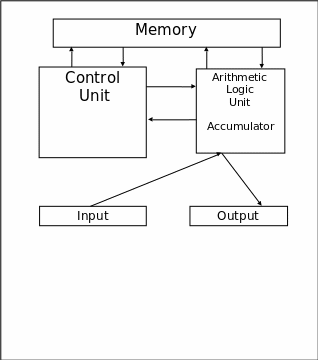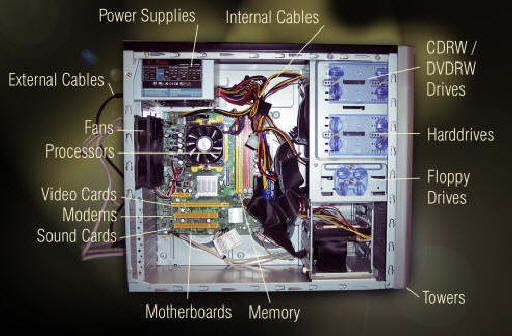Introduction
In the study of the computer architecture, it is paramount to consider the theoretical and the practical aspect of the computer architecture model. An exhaustive knowledge of both the practical and theoretical aspect of the computer provides a clear and comprehensive knowledge of the working architectural design of the computer. The theoretical model of a computer provides the reader with relevant functions of components inside the computer. There are various parts of a computer that perform different functions according to the specification and the designated purpose of a computer. The basic units of a computer model are as follows:
- Input device – This is a physical part of a micro-computer that is responsible for allowing information to be fed into the computer.
- Output device – This region of the computer is responsible for the output of information which can then be used by user.
- The processor – This is the main point at data processing occurs, the data that has been let into the system is manipulated and processed in this segment of the computer unit.
- Primary and secondary memory – This memory region of the computer is responsible for permanent and temporary storage of the information.
- Busses – Busses are responsible for the transfer of information from one point to another in the computer.
Theoretical method
Study if the internal architecture of a computer reveals the essential components that make up the structure of the computer. A computer is electronic device that can receive data input from it input peripherals, process the input instructions on its central processing unit then deliver the result of the processed information in form of output signal to an output device such as the monitor screen or a printing device.
The most foundational architecture of the computer was initially proposed by one of the earliest computer scientist called John Von Neumann. He proposed an architectural design that contained different essential part which jointly performed different purposes to achieve a common goal in the end. The Von Neumann model had the central processing unit, temporary and permanent storage unit and the input and output peripherals that allowed outwards communication with the computer. The Von Neumann architectural design has a central processing unit (CPU) which is made up of several logical registers that can hold data while it is being processed on. The CPU has enhanced built in operations set of instructions, the interpretation of the CPU is either as instructions or as fetched executable cycle.
The Von Neumann architecture also has a random access memory (RAM) that can read and write any memory instruction, this is normally achieved independent of the any previous instructions. As evident in computer theory, there is need of for a computer to communicate the processed information as shown by the Von Neumann architectural and Turing model.


Practical Method
To obtain useful information with regard to the computer architecture there is some important procedure to follow to obtain relevant information about the components that make up a computer. The procedure is a follows:
- Carefully open the lid on one side of the computer (The lid should open on itself without any force applied).
- The power cables disconnected from the hard disks and the motherboard.
- Remove the RAM cards.
- Remove the hard disks.
- Remove the fans.
- Open the caps holding the motherboard to the tower body.
The components of the computer are visible in the way that they are connected, the ROM of the computer is visible as it is normally attached to the motherboard.
Functions of various parts of a computer
As shown in figure 3 below, a computer is made up of several components that jointly make it possible for the computer to function properly. These hardware parts are as follows:
- The processor – The processor is responsible for the logical operations that a computer has to manipulate when processing data.
- Heat sink – The heat sink is responsible for cooling down the processor as it runs its operations.
- Fans – The fans are also responsible for generating a cooling effect on the machine and especially the processor as it works together with the heat sink
- Hard disk – The hard drives usually store data in the computer; it is therefore a storage unit in a micro-computer. This drive is also the main storage unit of a
- DVD/CD ROM – This drive is usually used to read and write information to a compact disk. Some advanced versions of this drive can burn information into a compact disk.
- Motherboard – This part of the computer is normally the main circuit board that joins the various components of the computer
- Busses – Busses of a computer are mainly responsible for the transmission of signals from one point of the computer to the other.
- Keyboard – This is the main input device of a computer, instructions are supplied via the keyboard. It is the most widely used input device.
- Mouse – This is another input device that is mainly used to the supply of information into the computer.
- Monitor – This is the computers main display unit or rather the display unit, it is mainly used to output processed information.
- RAM and ROM – RAM stand for, Random Access Unit, it mainly stores temporary information in what is called a queue.

Conclusion
As proposed by Von Neumann model, there are basic components of a computer that makes up the overall structure. The essential parts of the Neumann model are the input, output and the processing unit. Neumann also proposed the memory region which as earlier explained is responsible for the temporary manipulation of data. The figure 1, 2 and 3 show the theoretical Neumann model and the practical model as the photo was taken in the laboratory. As explained in the theoretical approach, there is a clear link of the described parts and the practical part that was demonstrated by opening the lid of the computer. The picture shows the memory location and the storage units as described by the two models.
Works Cited
Bell, Gordon C. and Allen N. Computer Structures: Readings and Examples. New York: McGraw-Hill Book Company, 2004.
Davis and Martin. The universal computer: the road from Leibniz to Turing. New York: Norton & Company Inc, 2000.
Lukoff, Herman. From Dits to Bits…: A Personal History of the Electronic Computer. Mexico: Robotics Press, 2003.